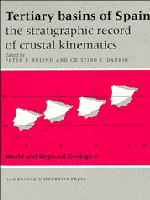Book contents
- Frontmatter
- Contents
- List of contributors
- Preface
- Dedication to Professor Oriol Riba IArderiu
- Memorial, Etienne Moissenet 1941–1994
- PART G GENERAL
- PART E EAST
- PART W WEST
- PART C CENTRE
- C1 Structure and Tertiary evolution of the Madrid basin
- C2 Neogene tectono-sedimentary review of the Madrid basin
- C3 Sedimentary evolution of lake systems through the Miocene of the Madrid Basin: paleoclimatic and paleohydrological constraints
- C4 Paleomorphologic features of an intra-Vallesian paleokarst, Tertiary Madrid Basin: significance of paleokarstic surfaces in continental basin analysis
- C5 Tectono-sedimentary analysis of the Loranca Basin (Upper Oligocene–Miocene, Central Spain): a ‘non-sequenced’ foreland basin
- C6 Paleoecology and paleoclimatology of micromammal faunas from Upper Oligocene – Lower Miocene sediments in the Loranca Basin, Province of Cuenca, Spain
- C7 Fluvial fans of the Loranca Basin, Late Oligocene – Early Miocene, central Spain
- C8 Saline deposits associated with fluvial fans, Late Oligocene – Early Miocene, Loranca Basin, Central Spain
- C9 Shallow carbonate lacustrine depositional controls during the Late Oligocene – Early Miocene in the Loranca Basin (Cuenca Province, central Spain)
- PART S SOUTH
- Index
C1 - Structure and Tertiary evolution of the Madrid basin
Published online by Cambridge University Press: 04 August 2010
- Frontmatter
- Contents
- List of contributors
- Preface
- Dedication to Professor Oriol Riba IArderiu
- Memorial, Etienne Moissenet 1941–1994
- PART G GENERAL
- PART E EAST
- PART W WEST
- PART C CENTRE
- C1 Structure and Tertiary evolution of the Madrid basin
- C2 Neogene tectono-sedimentary review of the Madrid basin
- C3 Sedimentary evolution of lake systems through the Miocene of the Madrid Basin: paleoclimatic and paleohydrological constraints
- C4 Paleomorphologic features of an intra-Vallesian paleokarst, Tertiary Madrid Basin: significance of paleokarstic surfaces in continental basin analysis
- C5 Tectono-sedimentary analysis of the Loranca Basin (Upper Oligocene–Miocene, Central Spain): a ‘non-sequenced’ foreland basin
- C6 Paleoecology and paleoclimatology of micromammal faunas from Upper Oligocene – Lower Miocene sediments in the Loranca Basin, Province of Cuenca, Spain
- C7 Fluvial fans of the Loranca Basin, Late Oligocene – Early Miocene, central Spain
- C8 Saline deposits associated with fluvial fans, Late Oligocene – Early Miocene, Loranca Basin, Central Spain
- C9 Shallow carbonate lacustrine depositional controls during the Late Oligocene – Early Miocene in the Loranca Basin (Cuenca Province, central Spain)
- PART S SOUTH
- Index
Summary
Abstract
The Madrid basin is intracratonic and triangular in form, being bounded on its three sides by Tertiary mountain ranges: the Spanish Central System in the north, the Toledo mountains in the south, and the Iberian and Altomira ranges in the east. The Altomira range separates the Loranca basin from the Madrid basin (Fig. 1). Each of these mountain ranges has a different structure and Tertiary geological evolution. The kinematic history of each of these borders of the Madrid basin reflects differences in the transmission of stresses from the active Iberian plate boundaries where the Betic and Pyrenean chains themselves had distinctive kinematic histories.
Geological setting
The crust of the Madrid basin and its surroundings is characterised by: 1. a Variscan basement (Palaeozoic metamorphic rocks with granitoids); 2. a pre-tectonic cover of Mesozoic and Early Cenozoic age (the former thinning gradually and then disappearing westwards); and 3. a syn-to post-tectonic cover of alluvial, fluvial and lacustrine sediments of Late Oligocene to Late Miocene age.
The structure of the borders of the Madrid Basin
Spanish Central System (SCS)
This is a linear mountain range that trends ENE–WSW, forming the Guardarrama Mountains, and then changes to trend E–W in the west, where it forms the Gredos Mountains. The altitude of the range is commonly 1500 m higher than the surface of the Madrid basin. The basement forms a core, flanked by the pretectonic cover.
- Type
- Chapter
- Information
- Tertiary Basins of SpainThe Stratigraphic Record of Crustal Kinematics, pp. 263 - 267Publisher: Cambridge University PressPrint publication year: 1996
- 7
- Cited by



